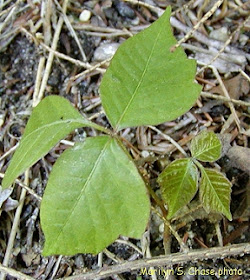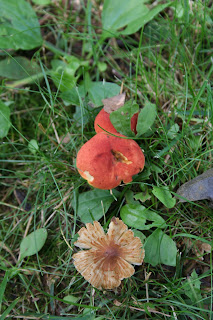MG Jill Hudock wrote this post a few months back, and I've held off putting it up until the Yuccas started to bloom in our area. Since that time has come, here's Jill.
 |
| Variegated Yucca in MG Jill Hudock's Landscape |
Howdy fellow gardeners! In this article I am bravely going where no other article has gone before…into Yucca territory. It is not an easy journey. It requires an open mind, heart and imagination. So c’mon, saddle up for a little adventure in landscaping. I promise you’ll be savvier at trip’s end.
The Plant
Native to the southeastern US, but more predominately displayed in southwestern xeriscapes,
Yucca filamentosa is 2 x 2 foot evergreen perennial with definite presence. Even its name evokes a reaction. Some folks, upon seeing it, do indeed say, “Yuck-a”. Here’s where an open mind is the key to discovery, as a closer look may prompt reconsideration.
When taking that closer look, check out the curly, thread-like filaments entwining through the lance-like leaves, hence the species name “filamentosa”. They peel back from the leaf as it grows, eventually dropping off. The effect reminds me of a very bad hair day. Its frizzies contrast dramatically with its bold, overall appearance. Somehow this is an endearing quality. As if to say, “Yes, I’ve got very pointy, sharp, needle-like ends but at my core I’m just a fuzzy wuzzy”…now doesn’t that tug on your horticultural heartstrings??
 |
| Variegated Yucca in MG Jill Hudock's Landscape |
Yuccas are technically classified as perennial subshrubs, a fancy way of saying they provide year round visual support to the garden. They add a much-needed boost, especially in winter and early spring. The leaves remain at attention throughout most of growing seasons. No slouching allowed! However, some cultivated varieties do tend to droop, which may or may not be aesthetically pleasing. That is for you to decide, of course.
Yucca filomentosa adds a natural focal point to your landscape in a variety of leaf colors: solid green, greens with yellow striping or a fascinating misty blue.
In summer large, dramatic 6 foot sturdy stalks are loaded with fragrant, ivory bell-like flowers. No staking required. Seeds are produced by summer’s end. At this point the stalks may be cut down.
Recent surveys have shown the public is keen on incorporating edibles into the landscape. Yuccas may have value in that regard. Some folks enjoy cooking the seeds and using the flower petals in salads. Please research this before trying, as there are definite tips to follow. A very entertaining and educational website is
www.eattheweeds.com Bon appétit!
Yuccas even have their own exclusive pollinating insect, the
Yucca Moth (
Tegeticula sp.). Its life cycle is singularly dependent upon its host. How neat is that? Check out Lady Bird Johnson’s website for great photos and moth information at
www.wildflower.org as well as the U.S. Forest Service Wildflower Website
here.
Propagation occurs by seed, root cuttings or separating basal offshoots from the parent plant. Even though they grow slowly, placement is key. The taproot will regenerate if not completely removed, producing a new baby Yucca.
They aren’t picky about soil or sun, though they prefer full sun and will withstand drought conditions and salt spray. However, they will not tolerate wet situations. As far as plant health concerns go, no serious diseases or insects afflict them.
Plant Usage
I have included the variegated Yucca ‘Color Guard’ in many landscape designs over the years. Its soft yellow center stripe is flanked by medium green margins. A 3 foot flower stalk appears in mid-summer. When the client is presented with its photo, their reaction is often “Hmmm” which is client-speak for “No, thank you, not for me.” This can also be accompanied by an incredulous stare because we were doing so well up to this point. I totally understand.
After agreeing that most Yuccas, even the sublime ‘Color Guard’, can have an almost menacing appearance with their sword-like leaves, I launch into my “Stalwart of the Garden” mini-speech. This usually brings the client around to at least understanding the validity of choosing a “structural” plant. Or they are so glad that I’m done “informing” they just nod numbly. They still may not be in love with its lack of dainty posies or its dearth of “cuddly” leaves, but they are now an educated homeowner/gardener. Yes!
Those clients who immediately express an appreciation for this plant are the ones who like clean lines, simple composition and don’t mind something a bit quirky.
I like to add a Yucca into a cottage garden composition because it will balance out the more romantic, softer textures. A garden full of pretty floppers and weavers needs this kind of visual support. You know who they are….the cosmos, the daisies, the peonies…to drop a few names.
Yuccas balance informality with formality, creating an appealing combination. Try one in a container for a track stopping, “Whoa there, missy!” You don’t even have to add any other plants, but if you do, a trailer (vine or vine-like) and a filler (anything with rounded leaves or flowers) will support your workhorse nicely.
Plant Varieties
I love to see the sun backlighting the previously described ‘Color Guard’. The wow-factor is huge! A ground-hugging starburst! Totally mesmerizing!
Another interesting Yucca is ‘Bright Edge’ which has pale yellow striping on its leaf margins. This one isn’t as showy as ‘Color Guard’ but I like it for its sophistication...the little black dress of Yuccas.
Yucca rostrata ‘Sapphire Skies’ has recently shown up in catalogs. I circle it every time and have yet to order it. Guess I’m really waiting to see one in person. The description reads “stunning blue 3’-4’ yucca”. The accompanying photo reminds me of the diminutive
Festuca glauca ‘Elijah’s Blue’. I love my little ‘Elijahs’ for their soft, blue-gray tufted mounds. A very versatile ornamental grass, ‘Elijah’ would look lovely mimicking the much larger ‘Sapphire Skies’. Create a little horticultural drama by mixing two plants that look like big sister and little brother but yet are totally unrelated. Delishishly clever!
 |
| 'Elijah Blue' in Drought Tolerant Demonstration Garden |
 |
| 'Elijah Blue' in Drought Tolerant Demonstration Garden |
The Enlightenment
And while it is hard to reconcile the Yucca’s name with anything remotely chic, I submit that one must be imaginative, as well as adventurous, to fully understand its charms. It’s easy to fall back on a “yuck a” attitude towards this plant and then move on without giving it a try. If your landscape needs a bit of structure to complement its “prettiness”, then this could be a good option.
The other day a great friend, who also happens to be a well-respected local horticulturist, reminded me of an old memory that still makes her laugh. Apparently, in a fit of frustration, I had proudly declared myself a “Plant Snob”! I was tired of reading articles that were so politically correct they left no room for “the truth”, as I saw it. Glowing descriptions of attributes that only the plant’s hybridizer (AKA “ invested marketer”) could lovingly attest to were sticking in my craw. “Let’s call a spade a spade” was my battle cry! At least I kept it horticulturally-based.
Why do I bring this up now? I believe it’s good to be reminded that we all have our predilections. Ruts, in other words. Am I still a self-professed “Plant Snob”? Hmmmm…if so, I sure hope yucking it up will have changed my tune! And, maybe, yours too. Our little journey has ended and so, for now... “Happy trails to you…”.
 |
| Yucca fillamentosa agavaceae 'Bright Edge' |
There is a variegated
Yucca fillamentosa agavaceae 'Bright Edge' specimen at the entrance to the
Woodland Meadow Native Habitat Garden (AKA Wildlife Area Demonstration Garden), and a Yucca
Hesperaloe parviflora 'Perpa Brake Light' in the
Drought Tolerant Demonstration Garden.
 |
| Yucca Hesperaloe parviflora 'Perpa Brake Light' |
Looks like a critter took advantage of the 'edible' characteristic of the plant.
Update: Wednesday, June 26, 2013 - Last night's monthly MG meeting took place at Renfrew's four-square garden where we learned from
Dr. Doris Goldman that a plant in the middle of the design of the garden was often a Yucca, or "Our Lord's Sword". More on German four-square gardens
here.


















































